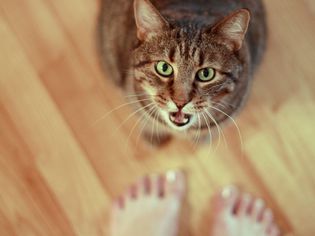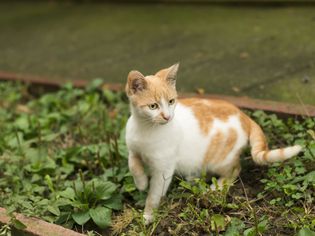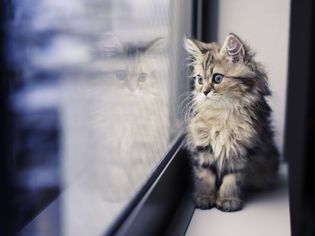The health benefits of blueberries are abundant. Blueberries contains vitamins, antioxidants, fiber and other compounds that help boost health in many ways, from supporting urinary-tract function to fighting cancer. People and dogs enjoy blueberries, but what about cats? Can cats eat blueberries safely, and if so, how many blueberries can a cat eat?
Some fruits are safe for cats to eat and some are not. As it turns out, blueberries are safe to feed to cats. In general, though, cats don’t eat much fruit. Unlike dogs, which are omnivores, cats are classified as “obligate carnivores.” This means that the majority of a cat’s diet must be comprised of meat—cats don’t require fruits and vegetables in their diet. For this reason, cats crave savory foods the most. In fact, you might be surprised to learn that domesticated cats physically cannot taste sweet things—they lack the specific taste receptor (called the TAS1R2 gene) required to be able to identify sweet flavors.
“But how can this be?” you might ask. “My cat loves ice cream!” Interestingly, some cats do enjoy eating things like ice cream and yogurt. Researchers have theorized that cats are in fact drawn to the fat content of foods like ice cream and yogurt, rather than the sweetness of these foods. (It’s important to note that cats should only eat very small amounts of dairy foods like ice cream and yogurt. Cats are lactose intolerant, which means they cannot digest the lactose that’s found in milk and milk products, so dairy foods can give cats stomach upset, including diarrhea and vomiting.)
The Benefits of Blueberries for Cats
Blueberries are considered a superfood, which is a food that provides additional health benefits above and beyond wholesome nutrition. Although most research about the health benefits of blueberries has been done on humans (and to a smaller extent, dogs), the known health benefits of blueberries might also help cats too.
Blueberries contain high levels of antioxidants (compounds that fight free radicals, slowing damage to the cells of the body). Antioxidants can slow the aging process and they may even fight cancer. Blueberry fiber can help reduce inflammation throughout the body, potentially easing conditions like arthritis and inflammatory bowel disease. Blueberries also support urinary-tract health (as do cranberries).
Potential Health Concerns
Although it’s safe and possibly even beneficial to feed your cat small amounts of blueberries as a treat in addition to her complete-and-balanced cat food, there is such a thing as too much of a good thing. Again, because cats are obligate carnivores, the majority of a cat’s diet should be meat. Although cats can eat and digest fruits and vegetables, too much could potentially cause stomach upset. Your cat should be eating high-quality, complete-and-balanced diet that meets a cat’s unique nutritional needs. Commercial cat foods include a statement on the label that states if the product is “complete and balanced” as certified by the American Association of Feed Control Officials (AAFCO). The complete-and-balanced statement on a cat food label means that the cat will get all the essential nutrients she needs, in the correct balance, as required for that life stage: adult maintenance (for adult cats), growth and reproduction (for kittens and pregnant or nursing females), or all life stages (for all cats, whether kittens or adults).
Any other food you feed your cat, including blueberries, should make up no more than 10% of your cat’s total diet (the remaining 90% should be your cat’s complete-and-balanced food). Because cats are small, limit blueberries to one to three blueberries per day.
What Kind of Blueberries Can Cats Eat?
Cats can eat fresh or cooked blueberries. Choose organic blueberries if you’re concerned about pesticides and other chemicals used to grow them. Even if you buy organic, always wash blueberries before feeding them to your cat.
Safe Ways to Feed Blueberries to Your Cat
If you can get your cat to eat blueberries, they can be a healthy treat for most cats. In fact, some commercial cat foods contain blueberries as an ingredient.
It’s always best to talk to your veterinarian before adding any new foods like blueberries to your cat’s diet. After you get your veterinarian’s OK you can give blueberries a try. Since cats can’t taste sweet things, they will be drawn to other qualities of blueberries. For instance, cats like new and interesting textures, so your cat might think it’s fun to chew on blueberries. Cats also like to eat wet foods, so a juicy blueberry might be just the ticket.
You might be surprised at your cat’s willingness to try blueberries as a treat. Try offering your cat whole raw blueberries, or cut them in half or smash them so your cat can see and smell the juicy insides. If your cat doesn’t seem interested, you can try mixing chopped raw blueberries or mashed cooked blueberries into your cat’s food. If your cat just doesn’t seem interested in eating blueberries, don’t force the issue.










Comments on " Can Cats Eat Blueberries?" :